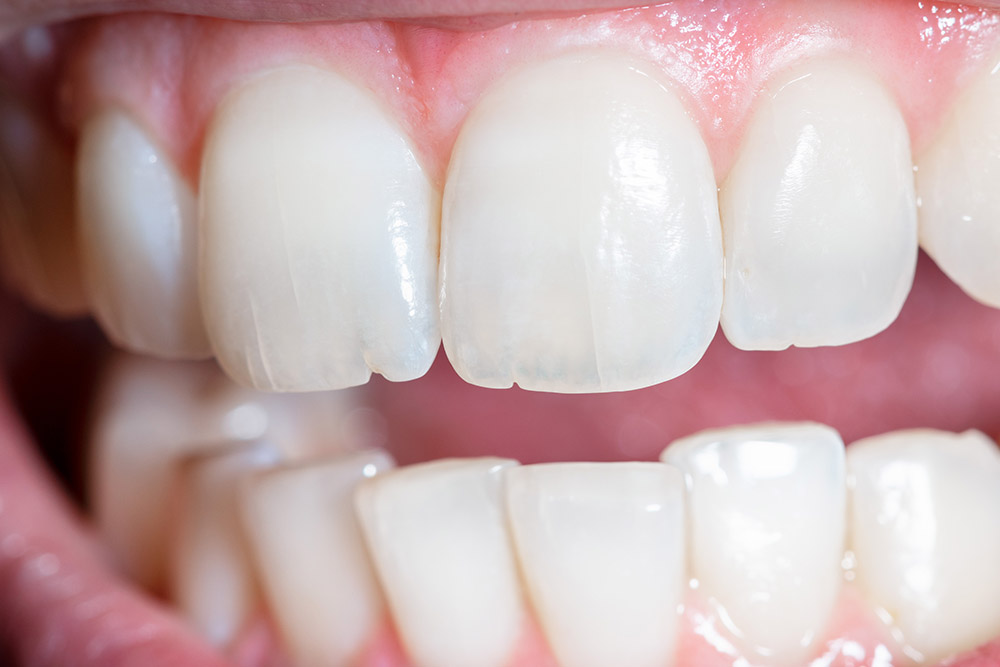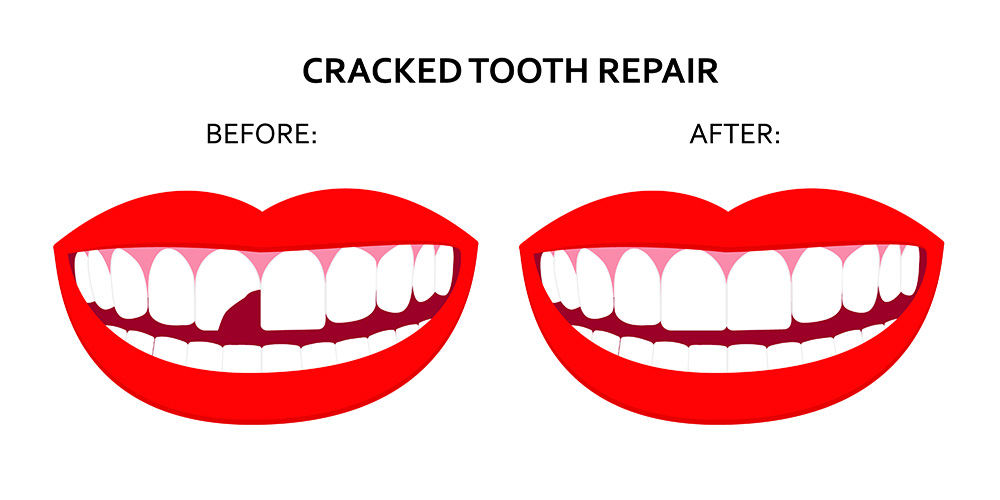Cracked teeth

Cracks (fractures) in a tooth are a non-carious violation of its integrity. Microcracks affect only the enamel layer. Larger cracks can damage the dentin and pulp. Such defects arise for various reasons. Sometimes the symptoms of fractures are pronounced. However, in their absence, patients often decide not to seek help from a dentist. Not seeking professional help can often lead to tooth decay in the future.
What types of cracks are there? Why do they occur? What are the symptoms that accompany them? How are cracks treated? Read more to see Dr. Tetri’s response to these questions.
Types of teeth cracks
According to the American Association of Endodontists, there are several types of cracks:
Often found in the smile zone of adult patients. They are shallow, painless, and do not require treatment. If the aesthetics of the teeth concern you, the dentist may suggest remineralization, artistic composite restoration, or veneer placement.

They usually occur on the molar teeth and can cause hyperesthesia to external stimuli. Often, such cracks penetrate the dentin but do not affect the pulp. They are eliminated with composite materials. If the pulp is affected, endodontic therapy is performed.
The fracture goes through the entire length of the tooth from the cutting edge to the base. The pulp may be damaged, but the root is not traumatized. The tooth does not split in half. The patient may experience prolonged pain. Treatment depends on the depth of the fracture. If it has not extended below the gum line, the dentist treats the tooth, performs root canal treatment and places a crown. If the fracture has advanced under the gum line, it poses a risk of necessary tooth extraction.
This type of injury usually results from frequent consumption of hard food. The tooth splits in half and the segments become loose. The crack passes through the bottom of the pulp chamber. Complications such as pulpitis and periodontitis can occur. Such teeth are rarely salvageable. In most cases, extraction with immediate implantation is indicated.
The fracture occurs in the root of the tooth and gradually spreads towards the cutting edge. Usually, this is the result of mechanical trauma or an unsuccessful attempt to treat or expand the canals. The defect is detected on an X-ray or already at the stage of tissue infection in the area of the injury. A fractured tooth is extremely difficult to save. Depending on the area of the crack, there are two solutions available: root resection or tooth extraction with subsequent implantation.
Why do cracks appear?
Large cracks typically occur as a result of mechanical trauma or after endodontic treatment of teeth with large fillings and thin walls. They also appear due to neglected small defects in the enamel that were not eliminated in time.
The formation of microcracks on the front and lateral can be a result of:
Abnormal bite or bruxism
(uncontrolled clenching of the jaw and grinding of teeth). Regular increased stress on teeth contributes to the formation of microcracks.
Sharp changes in temperature in the oral cavity
(for example, if you wash down ice cream with hot tea). The enamel cools down, then heats up sharply and cracks.
Frequent use of whitening toothpaste
They contain abrasives that erode and thin out the enamel. Gradually, the surface of the teeth weakens and cracks.
Smoking
Tar in tobacco smoke settles on the enamel. Over time, a dense plaque forms on the teeth. The enamel stops being saturated with minerals, weakens, and cracks.
Age-related changes
The composition of saliva changes with age. The restorative properties of enamel slow down. Dryness in the mouth occurs more frequently. Teeth become more fragile.
Carbonated and alcoholic drinks, coffee, and sweets
These products wash calcium out of the body. Bones, including teeth, lose their strength as a result.
Harmful habits
Cracks can form when opening bottles with teeth, biting on pens, seeds, candy.
Symptoms
The symptoms differ, depending on the depth of the crack.
Small cracks in the enamel are difficult to detect with the naked eye. However, they weaken the tooth. Chewing loads contribute to the expansion of fractures. Gradually, they can become larger. Usually, such defects can be noticed in good lighting or during an examination by a dentist. The dentist diagnoses fractures using a microscope, dental light, and enamel drying. Periodically, small cracks can provoke bouts of hyperesthesia.
Deep cracks are visible to the naked eye. Gradually, the area of the fracture darkens. An unpleasant odor may appear. The wall may be slightly loose. Chewing loads can lead to root fracture and sharp pain. Sometimes the defect is accompanied by increased sensitivity to temperature and chemical irritants.
Vertical cracks with root fracture are characterized by acute pain during chewing. Usually, part of the tooth becomes mobile. During examination, the doctor diagnoses tissue swelling in the area of injury. There is a risk of forming a fistulous tract in the gum.
What should I do if I cracked a tooth?
If the crack is deep and the pulp is affected, it is important to urgently visit a dentist. Delaying treatment reduces the chances of saving the cracked tooth. In the case of shallow cracks, it is also important not to delay treatment. They increase the risk of developing caries, pain during chewing, chipping of pieces, and even tooth loss.
Doctor’s advice
If you cannot see a dentist immediately, follow these recommendations:
- Rinse your mouth gently with an antiseptic solution every hour. This will help prevent infection from entering the tooth tissues.
- Take a pain reliever if necessary.
- Completely avoid chewing with the damaged tooth. Otherwise, the fracture may become larger, increasing the risk of a tooth fracture.
- Eat soft, mashed food at room temperature.
- Do not touch the injured area with your hands or tongue.
- Schedule an appointment with a dentist as soon as possible.
Treatment options for tooth cracks
The dentist chooses a treatment plan based on the size and location of the fracture. After diagnosis, the dentist may suggest one of the following treatment options.
Remineralization
Remineralization is used for microcracks within the enamel. The dentist performs a procedure called tooth fluoridation. A gel composition is applied to the teeth, which enriches the enamel with fluoride and calcium, and strengthens dental tissues. Remineralization reduces tooth hypersensitivity and restores enamel structure.
Composite restoration
Another way to fix small cracks. The dentist applies a filling material layer by layer to the affected tooth. Then, they polish and smooth the enamel to restore its natural shine.
Veneers
Veneers are thin, strong ceramic plates that are glued to the front surface of teeth in the smile zone. Veneers are precisely made to match the patient’s enamel color. Enamel preparation may be required before installation. Veneers are indicated if teeth have changed tone or have shallow cracks on the enamel. Such microprostheses restore the aesthetics of the smile and strengthen the enamel.

Crowns
Crowns are indicated for deep longitudinal fractures with pulp trauma and inflammation. The dentist prepares the tooth tissue, removes the vascular and nerve bundle, treats the canals, and fixes the crown. The crown isolates the tooth from the penetration of bacteria and the development of inflammation. For the smile zone, doctors recommend e-max ceramic crowns. For the lateral teeth, zirconia or metal-ceramic crowns are suitable.
Implant
If a tooth cannot be saved, it is removed and an implant is immediately placed. The surgery is carried out according to a one-stage protocol. A temporary crown is placed on the same day or within a week. The permanent prosthesis is fixed after 3-6 months.
Prevention of cracks formation
It is not possible to eliminate cracks on teeth without the help of a dentist. However, you can reduce the risks of their formation. Here are some recommendations:

